This aromatic and hearty pork stew, perfect for cold winter nights, is so easy to make. I like serving it in soup bowls, atop rice, cauliflower rice, or spaghetti squash noodles.
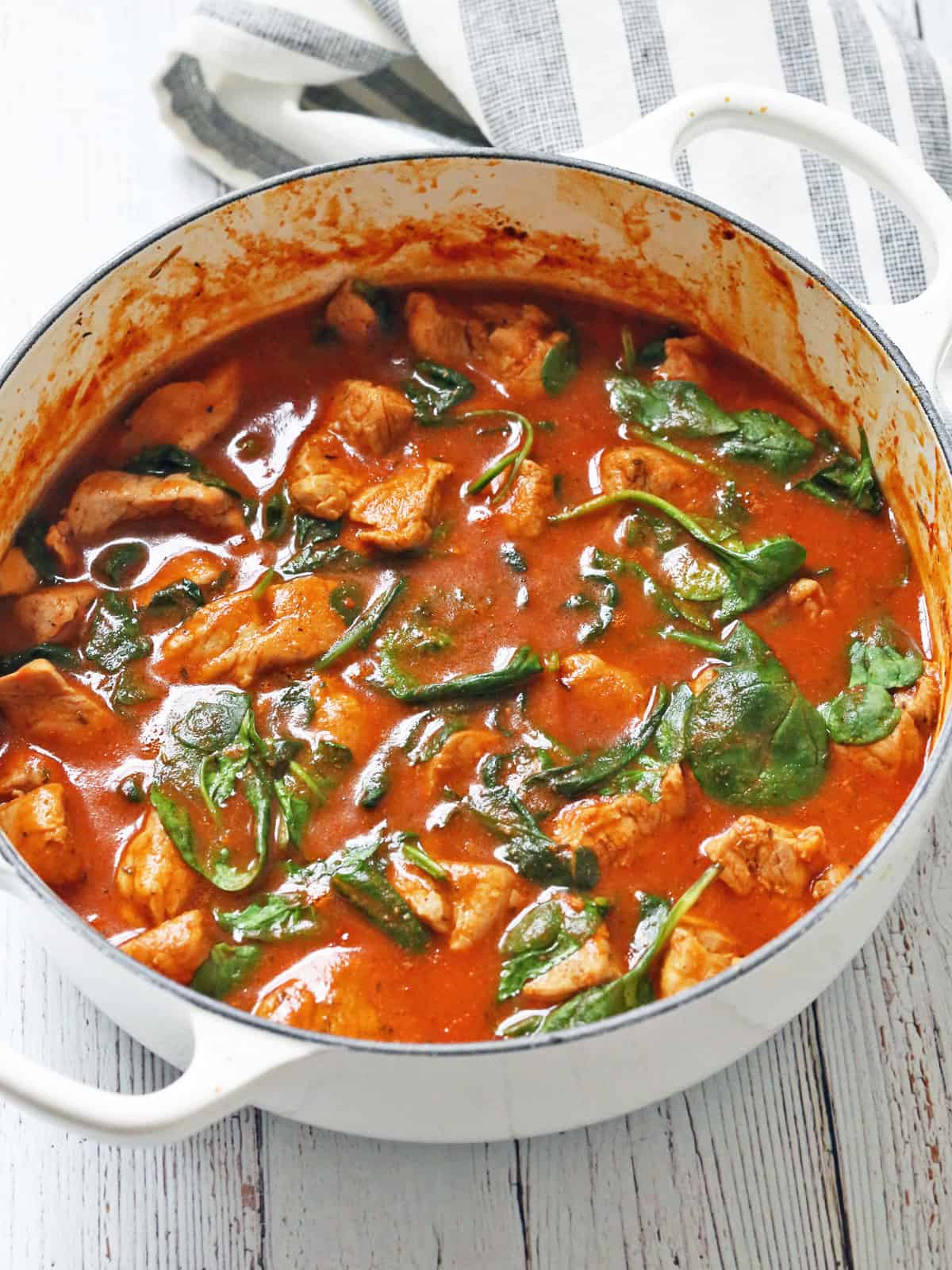
Stews such as beef heart stew, okra stew, and fish stew are among my favorite comfort foods. Many stew recipes require a lot of work, but this pork stew is easy to make. It's ready in 40 minutes! You can make it with just the meat or add veggies like spinach, broccoli, or cauliflower.
Ingredients
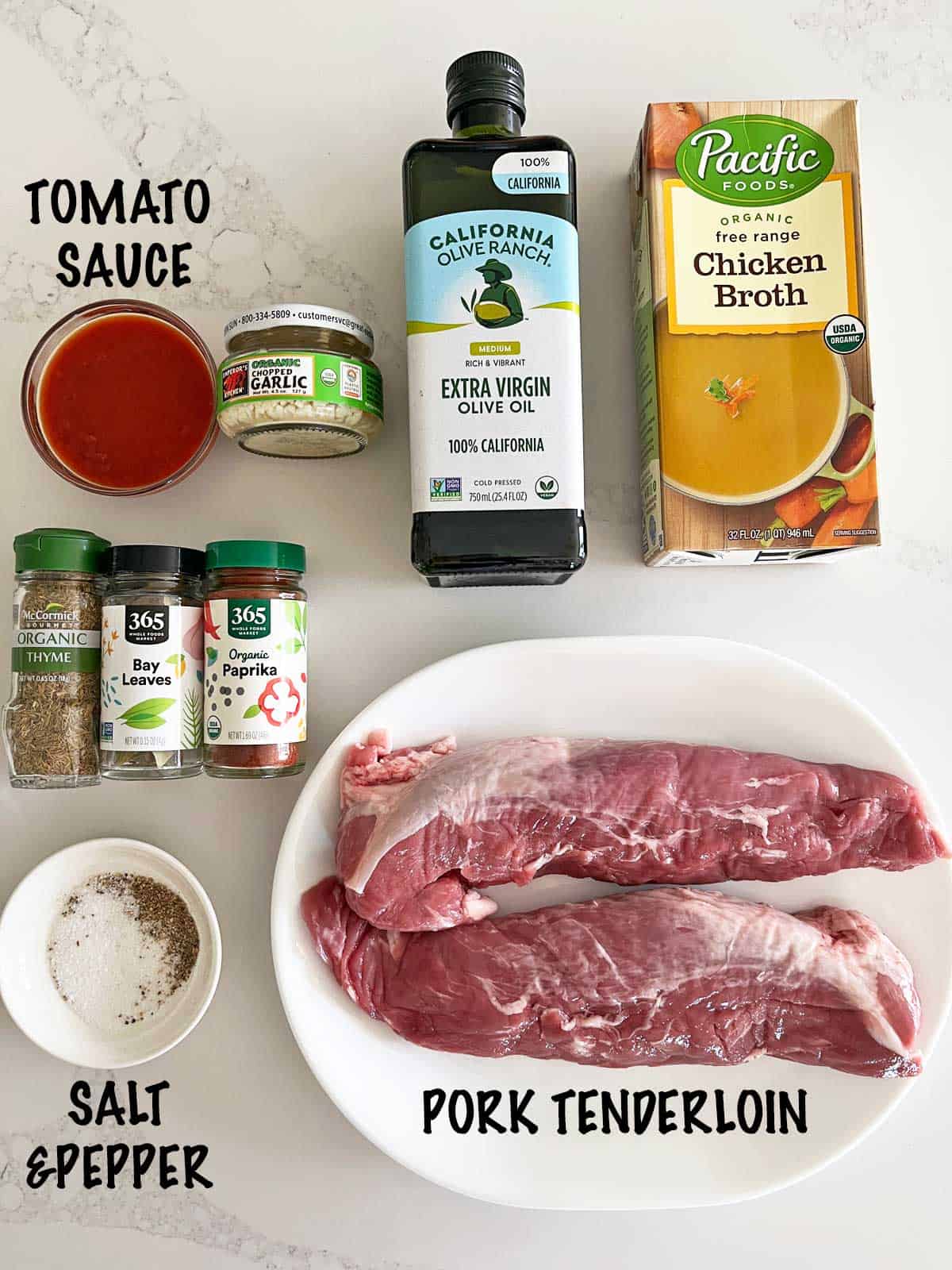
See the recipe card for exact measurements. Here are my comments on some of the ingredients.
- Pork tenderloin: You'll need two of them, each weighing around 1 ¼ pounds. Use a sharp chef's knife to cut them into 1-inch cubes.
- Minced fresh garlic: I use a full tablespoon, which may seem like a lot. But it adds great flavor to the stew.
- Chicken broth: I typically use a low-sodium broth by Pacific Foods. This enables me to better control the saltiness of the stew.
- Canned tomato sauce: I usually use the Whole Foods brand.
- Dried bay leaf: Adds an extra layer of flavor to the stew. It's not strictly needed here, so don't buy it especially, but it does make a difference in the dish's flavor profile.
- Cornstarch: A small amount - it acts as a thickener.
Variations
- Change the liquid: You can use dry white wine instead of chicken broth and serve the stew with the same wine. Sauvignon Blanc works well. Another option is to simply use water. While not as flavorful as broth or wine, the stew comes out great with just water.
- Change the spices: Sometimes, I use smoked paprika instead of sweet paprika. It adds a nice smoky flavor to the dish. You can use a heaping teaspoon of garlic powder if you don't have fresh garlic, or add a ½ teaspoon of red pepper flakes to add some heat to the dish.
- Add veggies: During the last 5 minutes of simmering the stew, mix in two cups of chopped vegetables such as small broccoli or cauliflower florets. Other (higher-carb) options include baby carrots or peas. You can also add a 5-ounce bag of raw baby spinach leaves to the stew once it's done. Add the spinach in batches, allowing each handful to slightly wilt before adding the next.
Instructions
The detailed instructions and step-by-step photos are included in the recipe card. Here's a quick overview.
Cube the pork tenderloins and season the cubes with salt and pepper. Cook them in olive oil. Add the garlic, paprika, and thyme, and cook them briefly. Add the broth and use it to deglaze the pan. Then, add the tomato sauce and bay leaf.

Bring the mixture to a boil, then lower the heat and simmer the stew for about 10 minutes, until the pork is cooked through and the sauce has thickened.

You can add small broccoli or cauliflower florets five minutes before the stew is done, or add baby spinach leaves at the end of cooking.

Wow! I had some pork stew meat and found this recipe. Just delicious and super easy. I added cauliflower, and it is so good with the pork. I had about 1.2 lbs of pork and just used the regular recipe, and it turned out amazing. I had been planning to make a slow cooker recipe, so I pulled out my slow cooker and discovered a crack, so I had to find an alternative. So glad I found this recipe. Can't wait to have leftovers tomorrow.
Joyce Morrell
Read more comments
Recipe Tips
- Pork tenderloin is a tasty cut, but it's lean and can dry out easily, so please make sure not to overcook it. According to the USDA, pork (except for ground pork) can be cooked to medium. There's no need for it to be cooked until it's well done.
- The pork cubes will probably have a small amount of fat attached to them. It's okay to leave it on. There's no need to trim it.
- If adding spinach leaves, add them in batches, allowing each handful to slightly wilt before adding the next.
Recipe FAQs
I use pork tenderloin. It's a lean and tender cut, perfect for a quick-cooking stew like this one. Pork shoulder is an option, too, but it's too fatty for this recipe. It needs to be cooked longer to melt away the fat. I use it when making a pork roast, pulled pork, or carnitas.
While this is true (with some limitations) for a fatty cut like pork shoulder, and assuming you use a slow cooking method, it's not true for a lean cut such as pork tenderloin. That's why I cook this pork stew for a short time.
Yes, but the stew will be thinner. The small amount of cornstarch I use helps thicken it without impacting its flavor or adding too many carbs.
You can keep the leftovers in an airtight container (as shown in the photo below) in the fridge for 3-4 days. Reheat them gently, covered (to prevent splatters), in the microwave at 50% power. You can also freeze the cooled leftovers in individual containers for up to three months.
Serving Suggestions
I usually serve this pork stew in soup bowls on its own or atop cauliflower rice or mashed cauliflower, as shown in the photo below:

If I didn't add any veggies to the stew (and sometimes even if I did), I like to add a side such as roasted cauliflower (shown below), roasted green beans, roasted asparagus, or steamed broccoli.
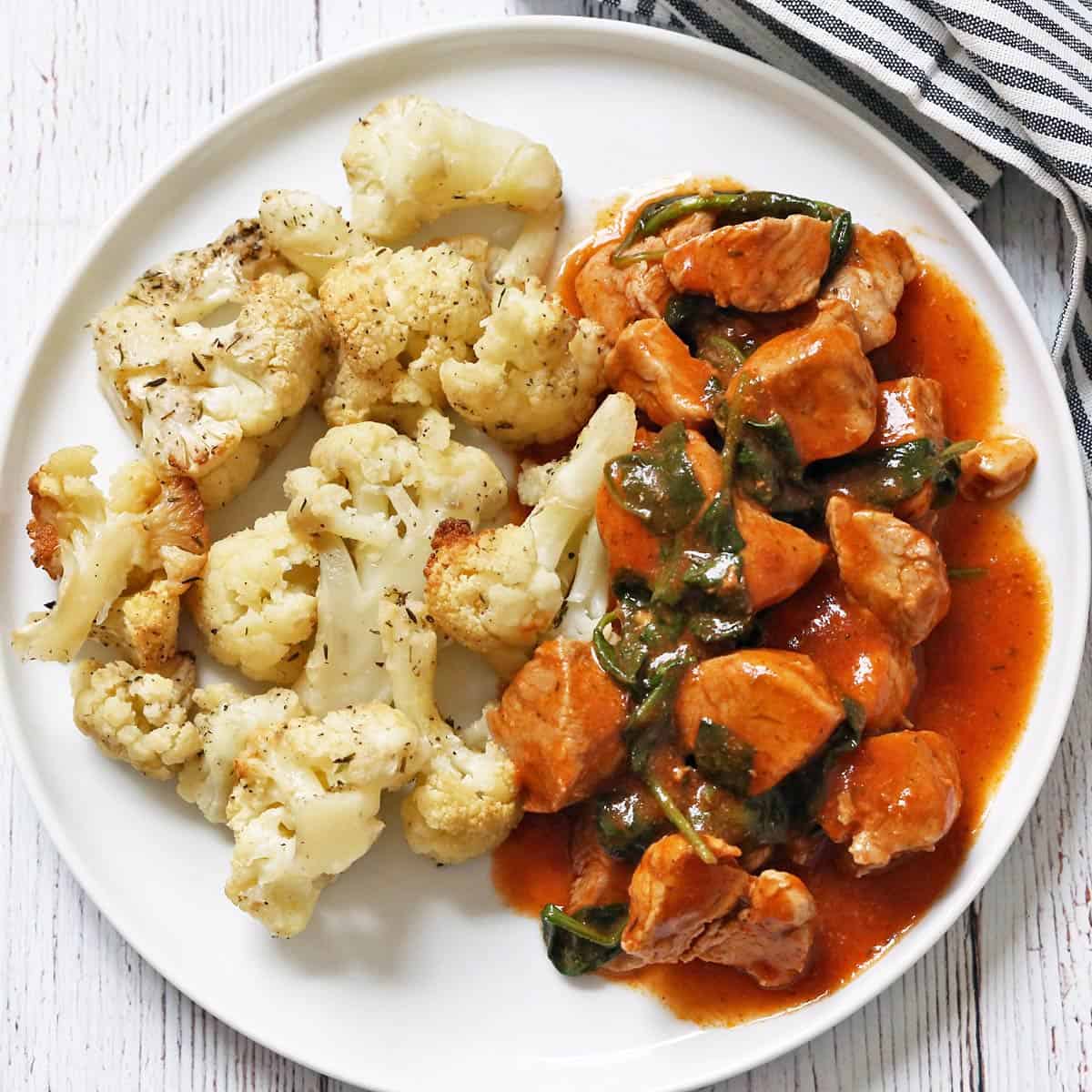
This stew is also excellent on spaghetti squash, zucchini noodles, shirataki noodles, or sautéed spinach.
Recipe Card
Quick 40-Minute Pork Stew
Video
Ingredients
- 2 tablespoons olive oil
- 2.5 pounds pork tenderloin - cubed into 1-inch pieces; 2 tenderloins
- 1 teaspoon Diamond Crystal kosher salt - or ½ teaspoon of any other salt, including Morton kosher salt
- ½ teaspoon black pepper
- 1 tablespoon fresh garlic - minced, or 1 teaspoon garlic powder
- 2 teaspoons paprika - or smoked paprika
- 1 teaspoon dried thyme
- ½ cup low-sodium chicken broth - or water
- 1 cup canned tomato sauce
- 1 dried bay leaf
Optional:
- 2 cups small broccoli or cauliflower florets - or 5 ounces of spinach leaves
- 1 tablespoon cornstarch - used to thicken the stew
- 2 tablespoons parsley - chopped, for garnish
Instructions
- Add the oil to a large, heavy 3-liter saucepan. Heat it over medium-high heat for about 2 minutes.
- Add the pork, kosher salt, and black pepper. Cook, stirring frequently, until the meat is no longer completely raw, about 5 minutes.
- Stir in the garlic (or garlic powder), paprika, and dried thyme.
- Add the broth (or water) and use it to deglaze the pan – scrape the bottom of the pan to loosen any tasty bits stuck to the bottom.
- Stir in the tomato sauce and bay leaf.
- Bring the stew to a boil, then lower the heat to medium and simmer, uncovered, for up to 10 minutes, stirring occasionally, just until the pork is cooked through. Don't overcook it - see notes below.
- You can stir in 2 cups of small broccoli or cauliflower florets five minutes before the stew is ready, or 5 ounces of baby spinach leaves right before it's ready (add the leaves in batches).
- If the stew hasn't thickened enough, mix in a cornstarch slurry (1 tablespoon of cornstarch mixed with 1 ½ tablespoons of cold water). Cook until the stew thickens, 1-2 more minutes.
- Remove the bay leaf, garnish the stew with chopped parsley (if using), and serve.
Notes
- Chewy meat means you've overcooked it. Pork tenderloin is a tasty cut, but it's lean and can dry easily. So make sure not to overcook it. According to the USDA, pork (except for ground pork) can be cooked to medium (145°F). There's no need for it to be cooked until it's well done.
- The nutrition info includes cornstarch and parsley. It doesn't include any veggies you might add.
- If adding spinach leaves, add them in batches, allowing each handful to slightly wilt before adding the next.
- Sometimes, I add a ½ teaspoon of red pepper flakes to add some heat to the stew.
- You can keep the leftovers in an airtight container in the fridge for 3-4 days. Reheat them gently, covered (to prevent splatters), in the microwave at 50% power. You can also freeze the leftovers in individual containers for up to three months.
Nutrition per Serving
Save this Recipe!
We will also add you to our weekly newsletter. Unsubscribe anytime. See healthyrecipesblogs.com/privacy/ to learn how we use your email.
Disclaimers
Most recipes are low-carb and gluten-free, but some are not. Recommended and linked products are not guaranteed to be gluten-free. Nutrition info is approximate. Please verify it independently. The carb count excludes non-nutritive sweeteners. Please read these Terms of Use before using any of my recipes.

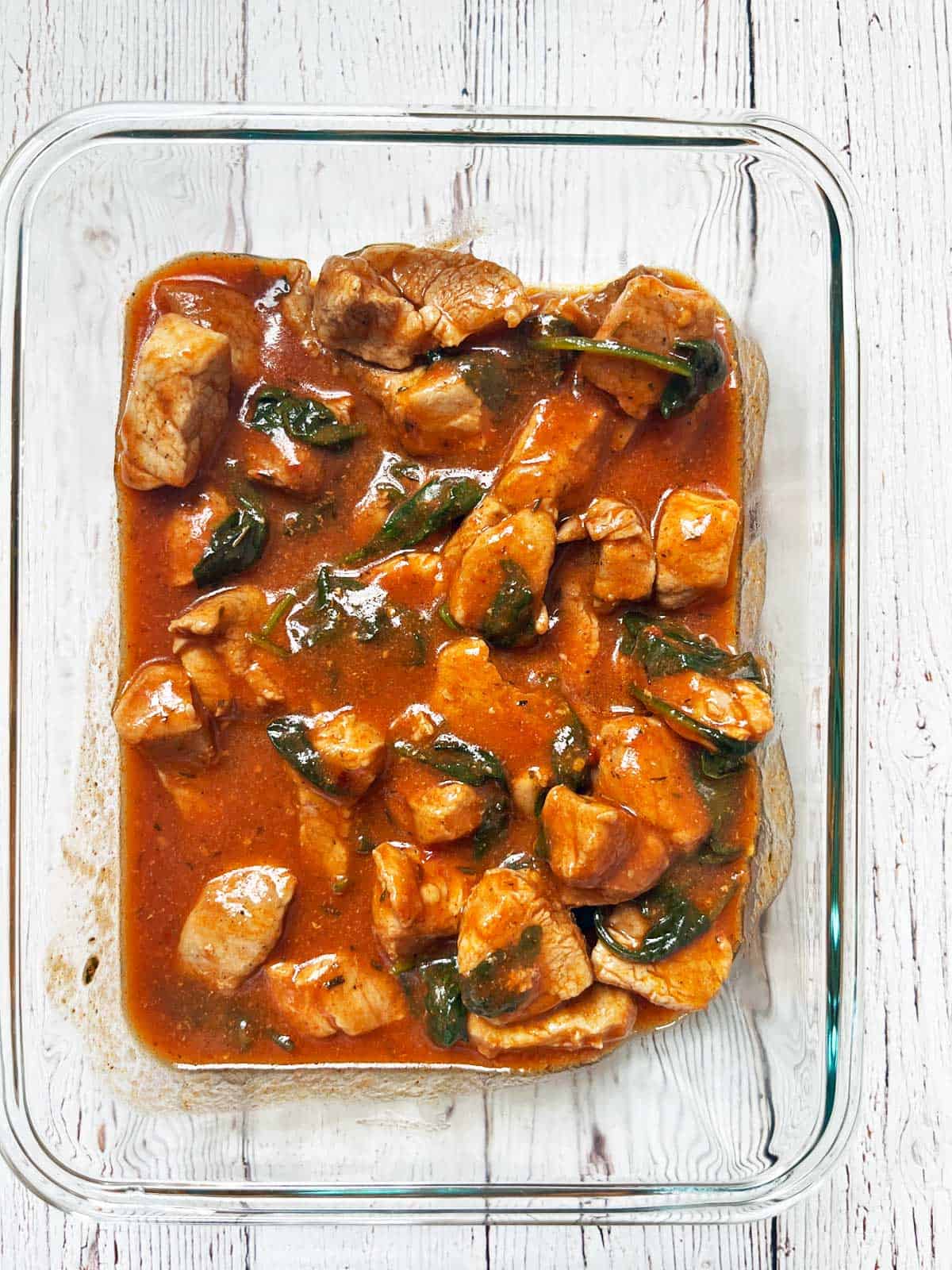

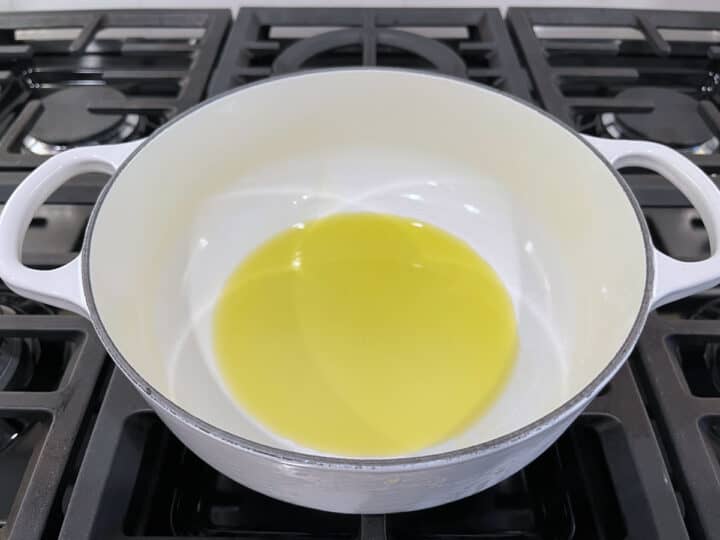
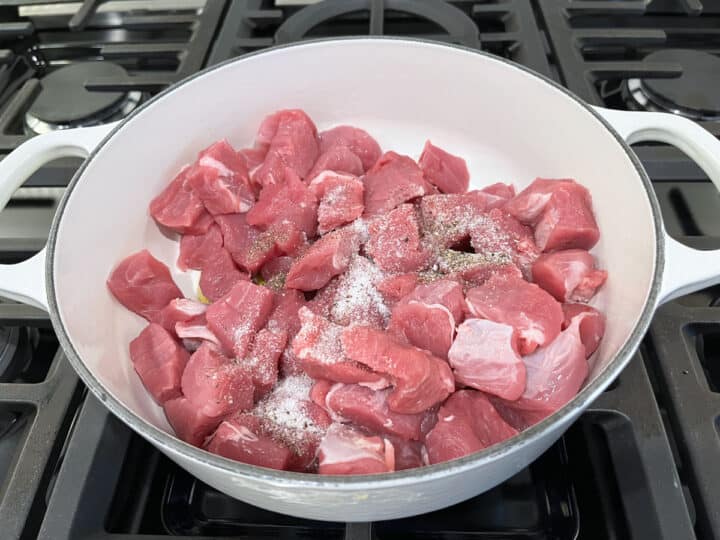
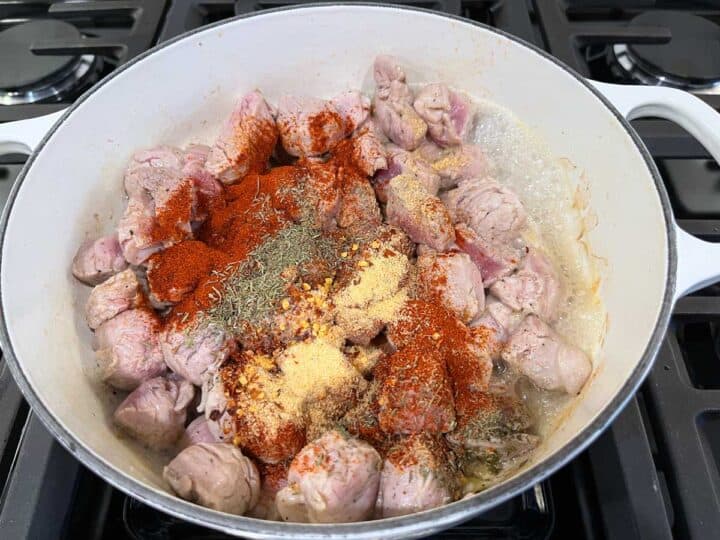
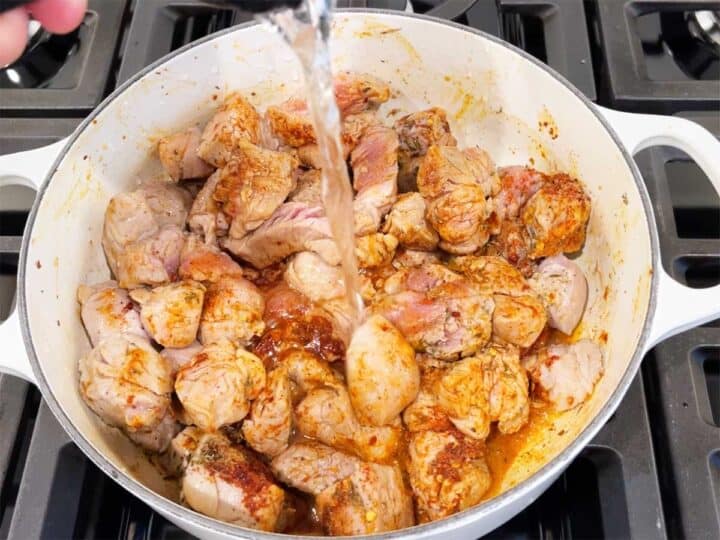
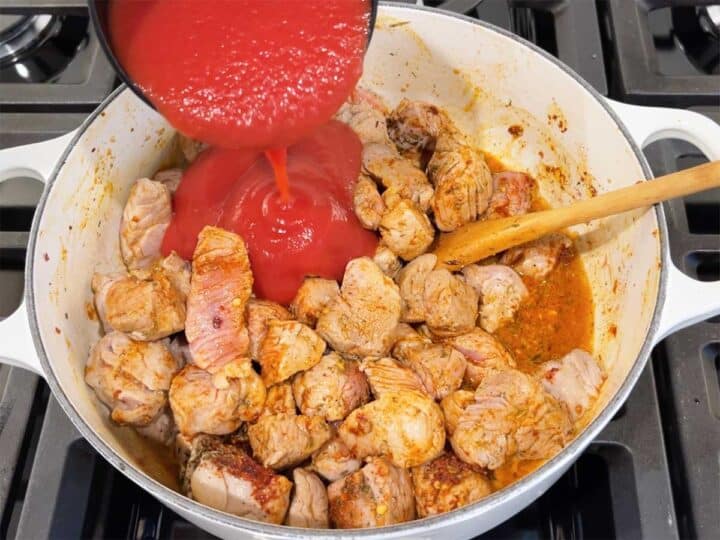
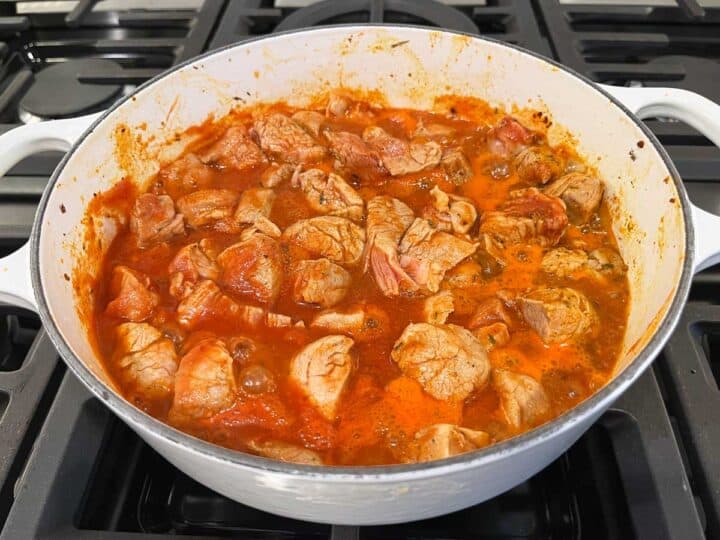
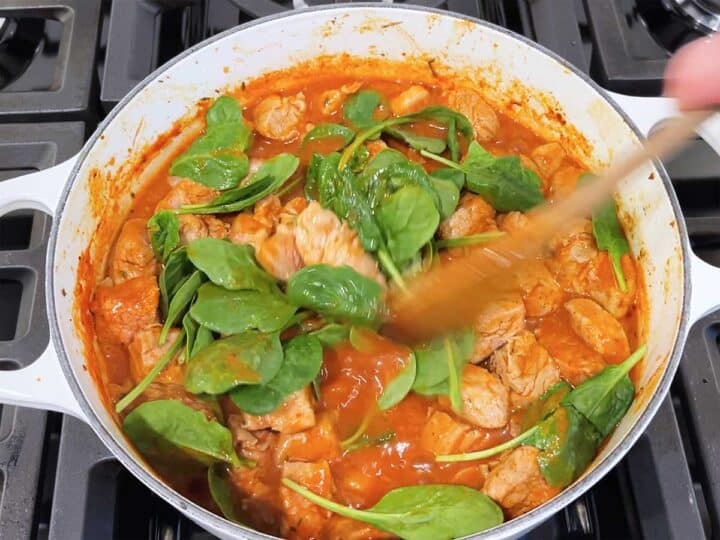


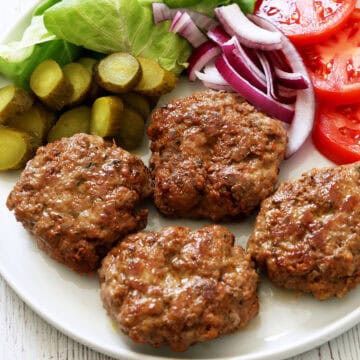



Joyce Morrell says
Wow! I had some pork stew meat, too. And found this recipe. Just delicious and super easy. Added cauliflower and so good with the pork. I had about 1.2lbs of pork and just used the regular recipe and turned out amazing. I had been planning to do a slow cooker recipe and pulled out my slow cooker and discovered a crack so had to find an alternative. So glad I found this recipe. Can't wait to have leftovers tomorrow.
Vered DeLeeuw says
Wonderful, Joyce! I'm so glad you enjoyed this recipe. Thank you for taking the time to write a comment.
Anne says
I had 1 1/2 pounds of pork stew meat, and discovered this recipe. So simple, yet so delicious. I loved the addition of cauliflower and fresh spinach. My husband had a second helping, which is unusual!
Vered DeLeeuw says
Yay! I'm so glad this was a success, Anne! Thank you for taking the time to write a review.
Ron Kadlecik says
Not a fan of tomato flavored sauces (they hide to much of the other ingredients tastes - what else can I use instead of the tomato sauce?
Vered DeLeeuw says
Hey Ron,
I'm afraid the tomato sauce is an integral part of this recipe. It sounds like this recipe is not the best choice for you.
Barbara marco says
I never have cornstarch in the pantry. Do you think a flour slurry will work just as well? It is on the stove right now. Marinated the meat overnight and the house sure smells great. I will be making egg noodles to pour it over and a chef salad, yeah! Excited for dinner.
Vered DeLeeuw says
Hi Barbara,
Yes, a flour slurry will work! Your meal sounds great.
Lamyku says
Delicious recipe! Easy to make and tastes great. I added vegetables like carrots, bell pepper, tomatoes and kale to the sauce and it turned out great.
Thanks for sharing the recipe.
Vered DeLeeuw says
Yay! I'm so glad you enjoyed this recipe. Thank you for sharing your delicious additions.
JenB says
It was glorious! I left work early as I was excited to make it. After I tried some, I splurged and added a bit of shredded cheddar because I am a cheese junky.
Vered DeLeeuw says
Yay! Thanks for coming back to share your feedback, Jen! Shredded cheddar sounds like a lovely addition.
Marian says
My family and I enjoyed this recipe. The pork pieces came out tender and tasty. The tomato broth is flavorful. I followed your advice and added a 5-ounce bag of baby spinach leaves. I served the stew over steamed rice (we're not low-carb). The cornstarch is important, as it helps thicken the stew.
Vered DeLeeuw says
I'm so glad you and your family enjoyed this stew, Marian! Thank you for the comment.
Leen says
Omg this was delicious! Family loved it!
Thank you
Vered DeLeeuw says
Yay! I'm so glad you and your family enjoyed this stew, Leen! Thank you for taking the time to write a comment.
Frank says
The taste was excellent. However, the meat turned out chewy. Also, why is it a stew when its just pork pieces - no potatoes, carrots, etc.?
Vered DeLeeuw says
Hi Frank,
It sounds like you overcooked the pork. Perhaps your stove burners run hotter than mine.
As for potatoes and carrots, I cook low-carb recipes, so I tend to avoid root vegetables.
JenB says
The trick to not overcooking pork is to get it to room temperature first, cook it on high heat with an oil that has a high temp smoke point. Avacado oil or ghee would work well. Once seared, pull out the pork, make the sauce and toss pork back into the sauce with spinach and let it finish off, which would not take long. Potatoes and carrots are not low carb, but it is still a meat in a sauce with a sort of vegetable incorporated in it so a stew of sorts. I think stew works. I am trying this recipe tonight!
Vered DeLeeuw says
I hope you like it, Jen! Thanks for the comment.